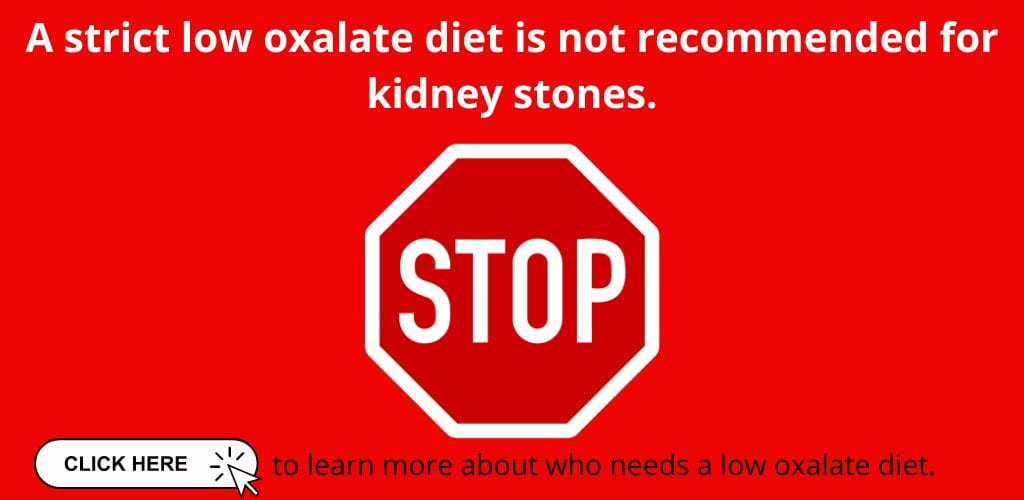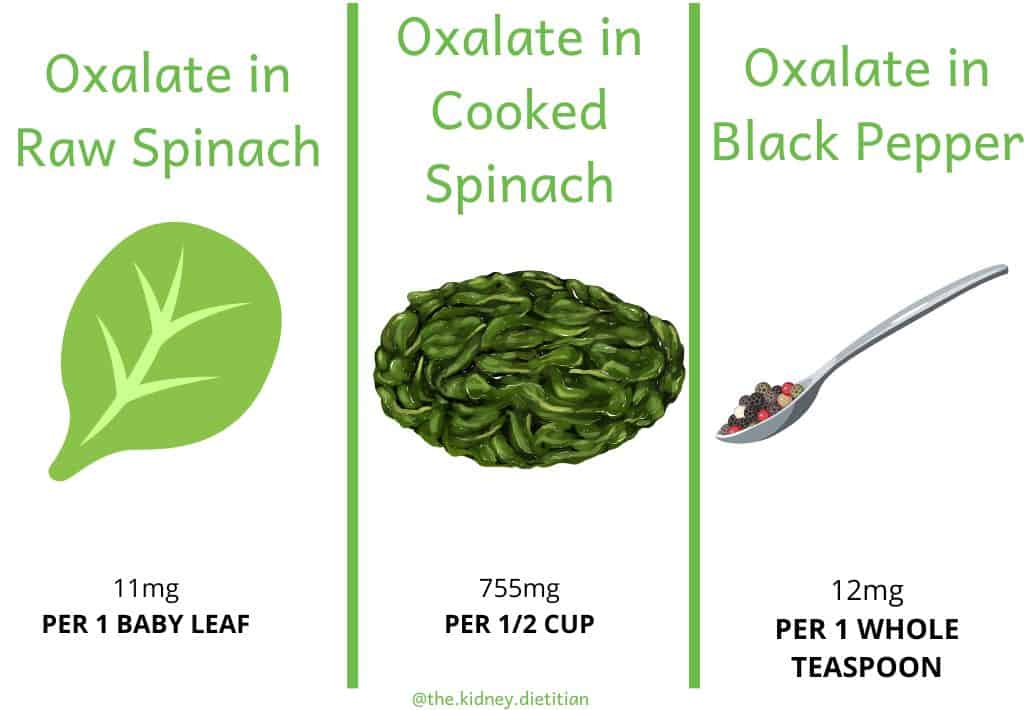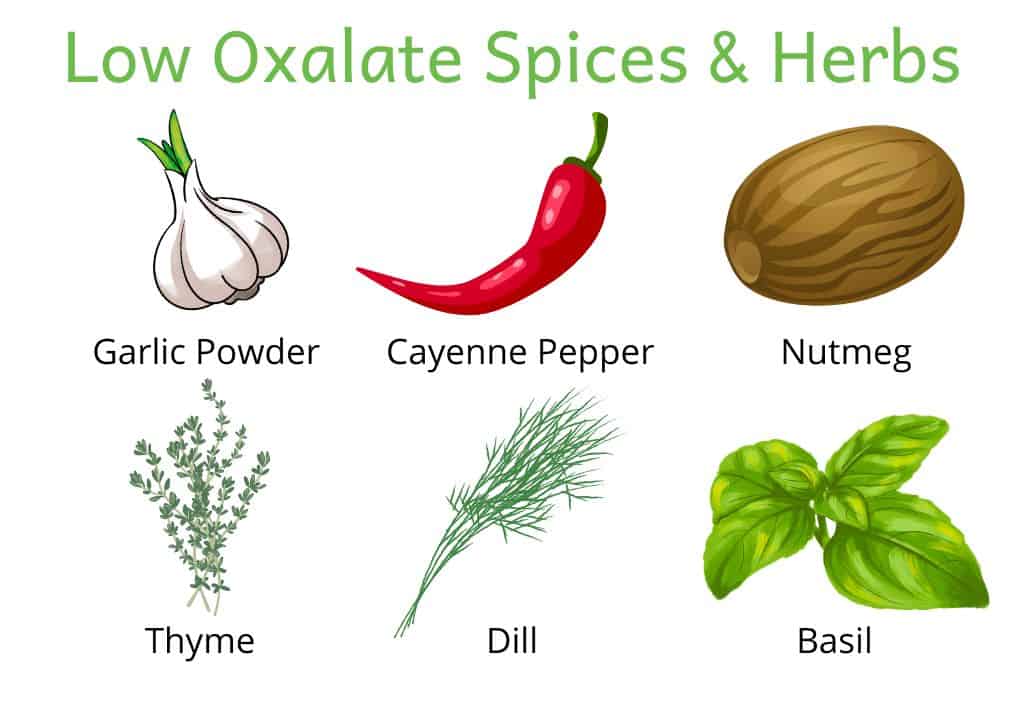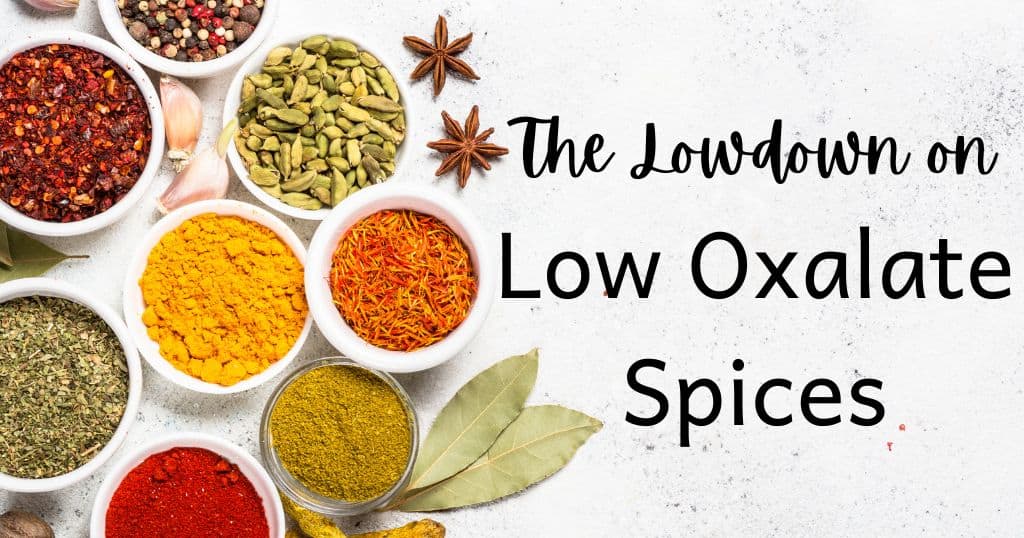Eeek! You read that some spices have oxalate in them. Your heart skips a beat and you start to Google what low oxalate spices you can use.
Firstly, don’t panic. The amount of oxalate spices add to your food is usually minimal. Chances are, you really don’t need to worry about oxalate in spices. I promise!

Table of Contents
Who Needs Low Oxalate Spices?
Firstly, who should be worried about low oxalate spices in the first place? Oxalate is blamed for a whole host of conditions. Nearly all of them have NOT been shown to be improved with a low oxalate diet.
Oxalate is most known for it’s role in kidney stone formation. Most kidney stones are made of calcium oxalate. However, high urine oxalate is not usually the cause of kidney stones (high urine calcium is!). Make sure you know what the cause of your kidney stone is before stressing about low oxalate spices.
The only way to know the cause of kidney stones is a 24-hour urine test. Chances are, there are other diet changes that would make a much bigger difference than a low oxalate diet.
The American Urological Association recommends reducing how much oxalate you eat, ONLY if you have high urine oxalate levels and confirmed calcium oxalate stones. They also recommend to make sure you are eating enough calcium (1,000-1,200mg per day).
How Much Oxalate Should I Eat?
The right amount of oxalate is different for everyone. Many people with kidney stones do not need do even consider oxalate in their food choices. IF you do have high urine oxalate, despite eating enough calcium, it does make sense to limit very high oxalate foods.
I DO NOT recommend “counting” oxalate or aiming for a certain amount of oxalate per day. There is no published guideline for how much oxalate a “low oxalate diet” is anyway! Instead, I recommend looking the foods you eat frequently to see if there are any very high oxalate foods that stick out.
Notorious High Oxalate Spices
These spices are most known for being “high” oxalate spices:
- Turmeric (50mg oxalate per teaspoon)
- Cinnamon (40mg oxalate per teaspoon)
- Clove (42mg oxalate per teaspoon)
Black pepper is often cited as being “high” in oxalate. However, a teaspoon of ground black pepper only has 12 mg of oxalate.
Does Oxalate in Spices Matter?
Remember, we need to look at the big picture here. How much oxalate is that cinnamon on your applesauce really adding to your day. Chances are, it isn’t significant.
Black pepper is perhaps the most notorious “high” oxalate spice. However, one entire teaspoon of black pepper has about the same amount of oxalate in a SINGLE baby spinach leaf. You likely are eating a LOT more than 1 baby spinach leaf, and likely a LOT less than an entire teaspoon of black pepper in one sitting.

High Oxalate Spices: When To Be Concerned
The only time I get remotely concerned about oxalate in spices with supplements.
Supplements are potentially a very concentrated source of a spice (and therefore oxalate). You can easily consume a much larger dose of oxalate in supplement form. However, you are likely not eating large amounts of spices in food.
The most common high oxalate supplements I see are:
- Cinnamon
- Clove
- Turmeric
- Green “superfood” powders and pills
Low Oxalate Spices: The List
Here are a list of low oxalate spices and herbs. Remember, for most people, ALL spices are “low oxalate” and can be enjoyed to make your food delicious. Honestly, the salt you cut out by using spices to make food delicious is doing you MUCH more good than choosing low oxalate spices.
Low Oxalate Spices
Spices lower in oxalate with estimated oxalate amounts.| Oxalate (mg per teaspoon) | |
|---|---|
| Chili Powder | 8 |
| Cayenne Powder | 6 |
| Allspice | 20 |
| Basil, dried | 9 |
| Cardamom, ground | 6 |
| Cumin, ground | 20 |
| Curry Powder | 24 |
| Dill, dried | 9 |
| Fennel Seed, dried | 22 |
| Garlic Powder | 0 |
| Ginger, ground | 16 |
| Nutmeg, ground | 2 |
| Oregano, dried | 8 |
| Onion Powder | 20 |
| Paprika | 6 |
| Parsley, dried | 6 |
| Red Pepper Flakes, crushed | 2 |
| Rosemary, dried | 9 |
| Thyme, dried | 2 |
| White Pepper | 1 |

Low Oxalate Spices: A Kidney Stone Dietitian’s Advice
For every single person I’ve ever worked with, I advise them to NOT WORRY about oxalate in spices used in cooking or on food. The amount of oxalate you are realistically going to get from even higher oxalate spices in minimal.
Instead, spend your energy diving into your 24-hour urine test to know what is REALLY causing your kidney stones. Chances are, you are eating too much sodium, protein or added sugar, too little calcium and produce, or simply not drinking enough water.
Happy Eating!
Melanie


Do you take Medicare and supplemental plan b insurance?
I don’t take insurance at this time.
Hi Melanie and thank you for your good work. I am a 67 yr old male and have had stones occur 3 times over the past 7 yrs….every 3 yrs or so. I took the 24 hour urine test and my stone source is oxalate. I have made some dietary changes this fall after the 3rd bout and your information has been so helpful especially with regard to calcium intake. Between not drinking enough water and eating a bunch of high oxalate food, I can see why I have been plagued and hope to reverse the trend! I do drink fennel seed tea as well as peppermint seed tea, both from a specialty outfit so the teas are perhaps more concentrated. Do you have any insight on either of those two teas and if I should limit intake at all?
Thank you, Paul
Hi Paul! Thanks for your comment. I don’t recommend avoiding tea at all – check out this post!
Hi. I find reading your articles to be very informative. I am wondering if you would share your daily eating habits. I am always so interested in what people eat to stay healthy. Again, I enjoy your articles.
Hi Susan! I’m so glad my posts have been helpful! I actually never share exactly what I eat in a day because it is highly unlikely anyone seeing it has the exact same nutrition needs as I do. Everyone has different health concerns, food preferences, budgets and priorities. As a dietitian, as soon as I put my “what I eat in a day” out there, it puts that food and that exact day on a pedestal, which is exactly the mindset I fight against. Instead, I try to educate people so they can make informed decisions about their bodies and their food. Hope that makes sense!
Hello… I’ve read mixed articles on raw garlic, whether it’s high oxalates or not. I’ve been taking a clove of raw garlic a day for a few moths which I noticed started helping me with some issues such as GERD. But then I started having kidney issues which all the symptoms point to a stone (I also have hyperparathyroidism which I know kidney issues can stem from that). Does raw whole garlic contribute to kidney stones, not powder, but raw garlic. And is it a high oxalate or no? Thank you.
Nope! The amount you would realistically consume is negligible.
I was looking for a natural blood thinner, is cayenne pepper worth taking?? thanks
I cannot recommend that. If you really do need a blood thinner, I would talk to your doctor about this.
So what do you recommend??
I don’t recommend using ANY herb or food as a “natural” blood thinner. If you do truly need a blood thinner, it would be dangerous to rely on something like this and would recommend medication and titrating it based on your bloodwork.
Hi Melanie, thanks for all the great advice. I’m just now getting through a 6th kidney stone over the course of 30years. The Dr. Recommended me not to keep taking my calcium supplement because of calcium oxalates found in tha stone. I’ve been eating salads for lunch over the last 22 years and four things in my salad were very high including beet root, kale, chard, and spinach. I also eat plenty of beef.
Hi Joe! I’m so glad you’ve found my site helpful! I agree calcium supplements generally aren’t ideal for calcium stone formers. Do know that kale isn’t high in oxalate at all. But, before you go down that low oxalate route, please check out this article. Most people MASSIVELY over-restrict oxalate and there are usually many more important things to focus on!
Hi!
Looking for oxalate values on a few things that I couldn’t find in your lists
Paprika powder
Chestnuts (regular, not water)
Hi Cara! For foods not on my list, I don’t have access to a reputable oxalate content. I HIGHLY discourage counting or keeping track of exactly how much oxalate you eat because this is truly an impossible task. Plus, oxalate is usually the LEAST of my worries when it comes to kidney stone prevention. I truly wouldn’t worry about it!
Hello, I was curious if you have any data on powdered dry mustard seed? This information is interesting to me for a different reason, because I have a hard time keeping my iron levels up, and I’ve read that oxalates can interfere not only with calcium absorption but also with other minerals like iron and even magnesium.
It actually is not recommended to avoid oxalate to maintain iron or any other nutrient. The cons of limiting SUPER healthy higher oxalate foods massively outweigh the possibly (likely negligible) impact they would have on the absorption of other nutrients such as iron or calcium. I honestly wouldn’t worry about it!
This article gave lots of very good PRACTICAL advice that puts a good perspective on oxalate in spices used in foods. They add such variety to a restricted diet that they are worth the bit of oxalate in them. One of the first diet changes we made in the family diet after my husband developed both CKD and CaOx kidney stones was to adopt no/low salt cooking and the rule is to taste your food first and if it is bland and “needs salt”, first add some pepper and then if it still needs more zip, you can add a small amount of salt that you can see, feel on your tongue and taste. My daughter even bought my husband a pepper mill.
Love it!
Working during the time of your lecture, will I be able to watch it later? Also, wondering if I take curcumin as a supplement for my brain is that kidney stone forming? I’ve had kidney stones since I’m 17 I am now 72. I’ve had a lithotripsy several times in the last five years. However, now I live in a portion of the country where there are very few urologists, and getting lithotripsy means Having stents put into the ureter for months until you can have lithotripsy.
Hi Sharon! Yes – just sign up for the class and you’ll get a link to watch the replay of the event.
I can’t say for sure what is best for you without knowing more about your medical history, but in general I advise against curcumin supplements for people who have a history of oxalate kidney stones.
Hope that helps!
Thanks for this helpful info! Just noticed that you also have cumin on the low oxalate list at 20 mg. Was that for a lesser amount?
Ah! This was a typo. I’ve fixed it! Thanks for letting me know.
Melanie: Am learning the twists of oxalate and blending foods based on having a type 2 diabetic also in my family. So am refining for a universal diet at home. However, my sister who is the kidney stone producer, is also a major right side stroke person, and as such calcium is not a factor I can consider…..it’s lack of movement/muscle strength that departed from the stroke on her right side. Sugar isn’t an issue since I read labels and keep that low due to Type 2…..Sodium too is managed since both have had heart issues too. Am actually keeping her ‘calcium’ higher with 2% milk, cheeses, yogurt, etc….and her urologist is trying to have her intestine’s extract the excess before it gets to her kidneys. Just thought I’d pass along that ‘stroke people’ fit an entirely different scenario when it comes to calcium
Tks, Esther D Kistler [email protected]
Thanks Esther for sharing! Having a history of stroke doesn’t generally mean you need less calcium. With this history, it does make sense to pay extra attention to WHERE you get that calcium and choosing lower fat dairy options makes sense!
Cumin appears on both the notorious list with 50mg per teaspoon, and on the low list with only 20mg per teaspoon. It’s a little confusing, especially when it’s my favorite spice.
This was an error! Thank you for pointing it out. I’ve fixed it in the article!